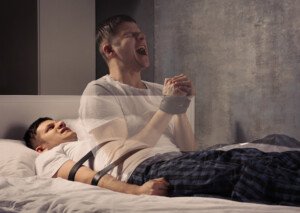
Doctors say sleep paralysis is from the brain vs. the paranormal OBE explanation?
Sleep medicine doctors quickly offer a logical explanation for sleep paralysis.
“When they’re experiencing sleep paralysis,” says Steven Bender, DDS, “they may have a dream when they are already awake.” Dr. Bender is director of the Center for Facial Pain and Sleep Medicine.
“People who experience sleep paralysis can have vivid hallucinations because they are dreaming,” says Dr. Bender in the report, which comes from Texas A&M University.
So this would explain the shadowy images in the room or the cretin sitting on top of your chest.
The brain thinks it’s still in the REM (dream) stage of sleep, so you see things that aren’t there. “They may have a dream when they’re already awake,” he adds. “People have felt like they’re levitating…”
Ahh, levitation. Could this be linked to an out of body experience (OBE)?
So we have the logical, rational, medical explanation for sleep paralysis, while there’s a whole other camp out there who believes that episodes of sleep paralysis are launching pads for OBE’s.
Some say that when you experience sleep paralysis, your astral double just re-entered your physical body.
Others suggest that your astral double is trying to exit your physical body.
This would explain the sensation of levitation, which includes partial levitation: just the astral legs lifting out of the physical body, or just the astral arms popping out.
But how do you explain the hallucinations? And the feelings of suffocation?
The Texas A&M report says that during REM (rapid eye movement) sleep, breathing is shallow and rapid, so this explains why, during sleep paralysis, you may feel as though you’re suffocating.
But if sleep paralysis is actually related to an OBE, why would you perceive difficulty breathing, feel that weight on your chest (the Old Hag sitting on it) or see “shadow people” or other alien-like beings in the room?
Could these be spirits or entities in the astral plane that you’re able to see into during these experiences?
If so, why doesn’t the astral plane reveal more pleasant things to “see,” such as flowers, birds, flowing water, angelic beings? Why don’t you hear music?
When experiencing sleep paralysis, I always try to have an OBE. But I’ve never been able to pull this off.
I concentrate and concentrate, imagining my astral self being released from my physical self and rising into the air, permeating my bedroom walls and making it outside, hovering above the parking lot.
But it just never happens. Why can’t I get this to happen? Other people swear that they’ve been able to succeed at this.
I’ve never been afraid of sleep paralysis. I’ve always intuitively known that it was somehow connected to the dreaming mechanism of the brain, even though my first experiences were when I was a child (though I can’t pinpoint the age, but I’d guess in upper grade school somewhere).
But in my adult years I began suspecting that maybe the OBE thing has some validity to it. I myself have never seen the Old Hag, shadowy figures or other beings, nor felt trouble breathing.
All I had was the paralysis (and an occasional buzzing noise), and quite interestingly, when these episodes run their course, and I’m just lying there, finally able to move…I’m actually able to pop back into the sleep paralysis state.
I do this because during the first episode, my attempt at an OBE failed. Maybe the next attempt won’t fail.
So I pop back into the SP mode. I fail to “get out” of my body; the episode runs its course; I can move.
I pop back into it again. After three or four pop-ins, I’m done; I just don’t have it in me to keep trying after that.
I can’t explain how I pop back into the sleep paralysis, but there’s a very small window of opportunity during which I can make this happen. If I wait too long, the pop-back-in won’t happen.
But when I do this, my eyes need to be closed.
So, failed OBE or is sleep paralysis a mere medical phenomenon of the human brain? You decide!

 From 2000-2015,
From 2000-2015, 






















